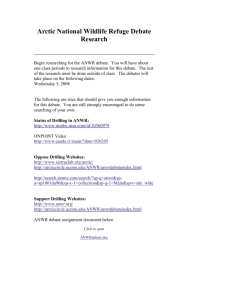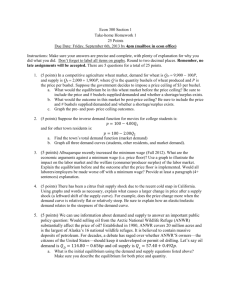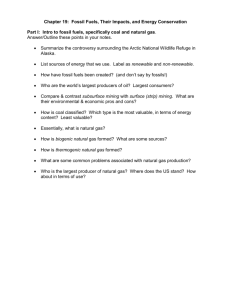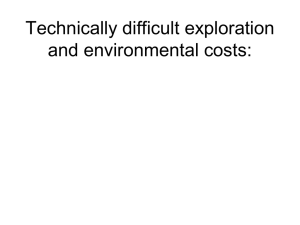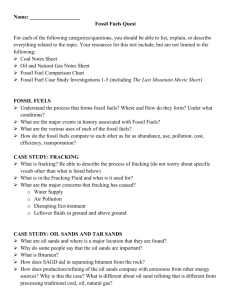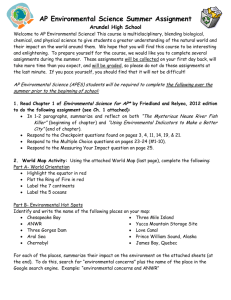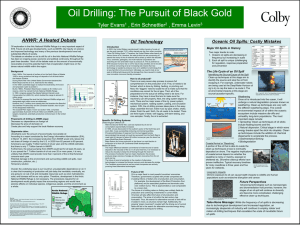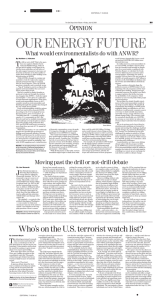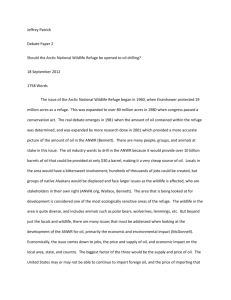Should we drill in the Arctic National Wildlife Refuge?
advertisement
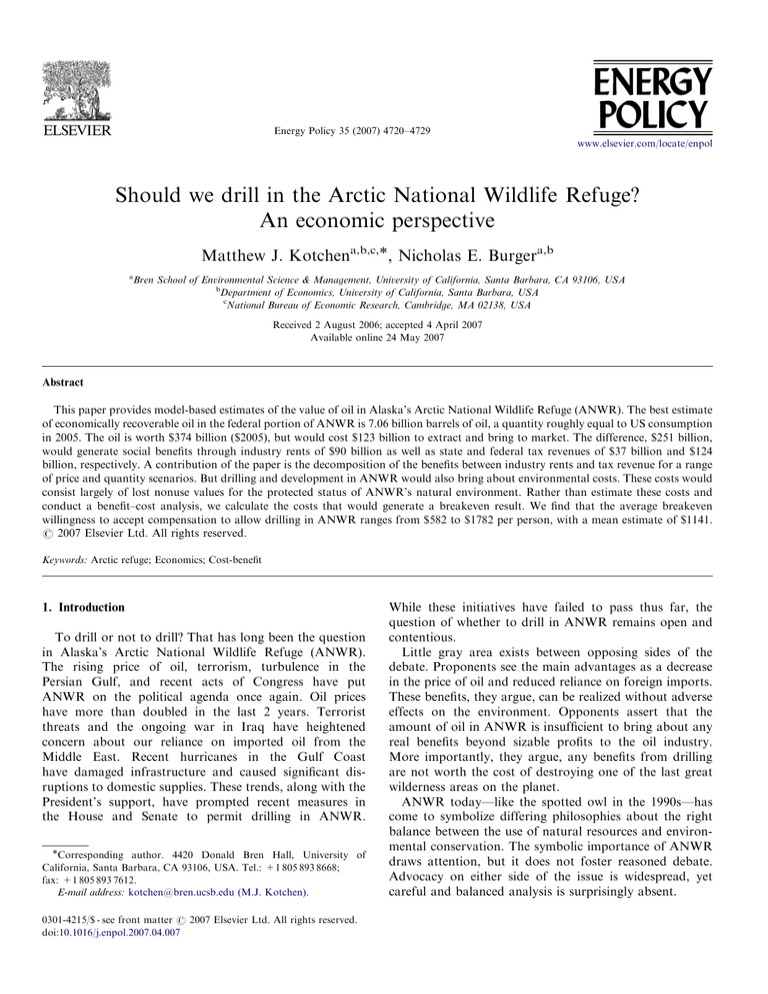
ARTICLE IN PRESS Energy Policy 35 (2007) 4720–4729 www.elsevier.com/locate/enpol Should we drill in the Arctic National Wildlife Refuge? An economic perspective Matthew J. Kotchena,b,c,, Nicholas E. Burgera,b a Bren School of Environmental Science & Management, University of California, Santa Barbara, CA 93106, USA b Department of Economics, University of California, Santa Barbara, USA c National Bureau of Economic Research, Cambridge, MA 02138, USA Received 2 August 2006; accepted 4 April 2007 Available online 24 May 2007 Abstract This paper provides model-based estimates of the value of oil in Alaska’s Arctic National Wildlife Refuge (ANWR). The best estimate of economically recoverable oil in the federal portion of ANWR is 7.06 billion barrels of oil, a quantity roughly equal to US consumption in 2005. The oil is worth $374 billion ($2005), but would cost $123 billion to extract and bring to market. The difference, $251 billion, would generate social benefits through industry rents of $90 billion as well as state and federal tax revenues of $37 billion and $124 billion, respectively. A contribution of the paper is the decomposition of the benefits between industry rents and tax revenue for a range of price and quantity scenarios. But drilling and development in ANWR would also bring about environmental costs. These costs would consist largely of lost nonuse values for the protected status of ANWR’s natural environment. Rather than estimate these costs and conduct a benefit–cost analysis, we calculate the costs that would generate a breakeven result. We find that the average breakeven willingness to accept compensation to allow drilling in ANWR ranges from $582 to $1782 per person, with a mean estimate of $1141. r 2007 Elsevier Ltd. All rights reserved. Keywords: Arctic refuge; Economics; Cost-benefit 1. Introduction To drill or not to drill? That has long been the question in Alaska’s Arctic National Wildlife Refuge (ANWR). The rising price of oil, terrorism, turbulence in the Persian Gulf, and recent acts of Congress have put ANWR on the political agenda once again. Oil prices have more than doubled in the last 2 years. Terrorist threats and the ongoing war in Iraq have heightened concern about our reliance on imported oil from the Middle East. Recent hurricanes in the Gulf Coast have damaged infrastructure and caused significant disruptions to domestic supplies. These trends, along with the President’s support, have prompted recent measures in the House and Senate to permit drilling in ANWR. Corresponding author. 4420 Donald Bren Hall, University of California, Santa Barbara, CA 93106, USA. Tel.: +1 805 893 8668; fax: +1 805 893 7612. E-mail address: kotchen@bren.ucsb.edu (M.J. Kotchen). 0301-4215/$ - see front matter r 2007 Elsevier Ltd. All rights reserved. doi:10.1016/j.enpol.2007.04.007 While these initiatives have failed to pass thus far, the question of whether to drill in ANWR remains open and contentious. Little gray area exists between opposing sides of the debate. Proponents see the main advantages as a decrease in the price of oil and reduced reliance on foreign imports. These benefits, they argue, can be realized without adverse effects on the environment. Opponents assert that the amount of oil in ANWR is insufficient to bring about any real benefits beyond sizable profits to the oil industry. More importantly, they argue, any benefits from drilling are not worth the cost of destroying one of the last great wilderness areas on the planet. ANWR today—like the spotted owl in the 1990s—has come to symbolize differing philosophies about the right balance between the use of natural resources and environmental conservation. The symbolic importance of ANWR draws attention, but it does not foster reasoned debate. Advocacy on either side of the issue is widespread, yet careful and balanced analysis is surprisingly absent. ARTICLE IN PRESS M.J. Kotchen, N.E. Burger / Energy Policy 35 (2007) 4720–4729 This paper draws on the best available information and provides original analysis. We approach the issue from an economic perspective. In the starkest sense, economic efficiency recommends drilling if the benefits exceed the costs. But calculating the benefits and costs of drilling in ANWR is not straightforward. The questions are big, and the information is highly uncertain. How much oil are we talking about? How much is the oil worth? What are the environmental impacts of drilling? How can we place a monetary value on the environment? And what problems might arise from putting a price on something that many people consider priceless? We address these questions here. Our best estimate of economically recoverable oil in the federal portion of ANWR is 7.06 billion barrels, a quantity roughly equal to US consumption in 2005. The oil is worth $374 billion (2005$s), but would cost $123 billion to extract and bring to market. The difference, $251 billion, would generate social benefits through industry rents of $90 billion, in addition to Alaska and federal tax revenues of $37 billion and $124 billion, respectively. While these are the best estimates based on recent oil prices, we also conduct a sensitivity analysis for a range of different price and quantity scenarios. While the environmental effects of drilling are uncertain, the environmental costs would consist primarily of lost nonuse values for the protected status of ANWR’s natural environment. While these costs are real and potentially large, the information necessary to account for environmental damage with any reasonable degree of precision is not currently available. Vast uncertainty exists about what the actual impact of drilling would be, and surprisingly little research has been conducted to place an economic value on the potential environmental costs. Consequently, rather than estimate these costs and conduct a standard benefit–cost analysis, we calculate the costs that would generate a breakeven result against the benefits. We find that the average breakeven willingness to accept compensation to allow drilling in ANWR ranges from $582 to $1782 per person of voting age, with a mean estimate of $1141. These results and others that follow provide useful benchmarks for economic analysis of the benefits and costs of drilling in ANWR. With regard to such policy questions, however, we are well aware that economics is not the only perspective that matters, and we readily discuss its limitations. At the same time, we argue that the economic perspective taken in this paper is central and that the empirical findings will contribute to greater evidence-based decision making on the future of ANWR. 2. Background In 1960, the year after Alaska became the 49th state, the federal government set aside 8.9 million acres to establish the Arctic National Wildlife Range. The area was located in the northeast corner of Alaska and extended from the state’s northern coast to south of the Brooks Range 4721 mountains. The designation was intended to protect the area’s unique wilderness, wildlife, and recreational values. Passage of the Alaska National Interest Lands Conservation Act (ANILCA) in 1980 more than doubled the size of the Range, adding 9.2 million acres and officially renaming it the Arctic National Wildlife Refuge. More importantly, ANILCA designated nearly all of the original land as part of the National Wilderness Preservation System making it off-limits to development. The coastal plain area, consisting of 1.5 million acres, was an exception. Because of the potential for vast oil and gas reserves in this area, Section 1002 of the Act called for further study of the oil and biological resources of the undesignated area, which is often referred to as simply the ‘‘1002 Area.’’ The Act also closed the 1002 Area to oil and gas exploration and development unless authorized by a specific act of Congress. The 1002 Area has been the primary source of conflict in ANWR, but it is not the only part of the Refuge where development of oil and gas resources can occur. There are Native lands within ANWR, although their legal status is such that they can be developed only if Congress decides to develop the 1002 Area. The state of Alaska offshore areas, which are designated up to 3 miles off the coastal plain, could also be developed, and they are not subject to federal decision making. Above ground, ANWR protects a broad spectrum of arctic and sub-arctic habitats that are, according to the Fish and Wildlife Service (FWS), ‘‘unparalleled in North America’’ (US Fish and Wildlife Service (USFWS), 2001). These habitats support a number of large animal species— including caribou, musk oxen, wolves, wolverines, and polar bears—and some 135 different bird species. The 1002 Area in particular is regarded as having the most productive and biologically important sections of the Refuge. These features have lead observers to remark that ANWR is ‘‘America’s Serengeti’’ and one of the ‘‘Last Great Wilderness Areas’’. 3. Oil in ANWR We begin the analysis with a fundamental question: How much oil are we talking about? Unfortunately, determining the precise amount of oil in the ground is an impossible task. Oil will always exist in places we have yet to look, and oil that we know exists is often not recoverable, at least not yet. Much of the oil, if not most, is simply out of reach with existing technologies, and much of the oil we do know about is not profitable to recover. Yet, as oil becomes more scarce, its price will increase, and the result will be better technologies and an expansion of profitable reserves. This dynamic implies that any estimate of oil reserves will certainly be wrong; it will change as time passes, markets adjust, and more information becomes available. We nevertheless need to start somewhere in ANWR. The most reliable and recent estimates come from a study conducted by the US Geological Survey (2001) ARTICLE IN PRESS M.J. Kotchen, N.E. Burger / Energy Policy 35 (2007) 4720–4729 4722 (Attanasi, 2005b). The study estimates the amount of ‘technically recoverable’ oil in the 1002 Area, the area that we focus on and refer to simply as ANWR. Technically, recoverable oil is defined as resources that can be recovered using current technologies without regard to cost. Recognizing inherent uncertainty, the study reports three estimates: a low estimate of 4.25 billion barrels of oil (BBO) with 95% certainty, a mean estimate of 7.69 BBO, and a high estimate of 11.80 BBO with 5% certainty. More importantly, the USGS study conducts an economic analysis to estimate the amount of ‘economically recoverable’ oil. This is defined as the quantity of technically recoverable oil for which the costs of finding, developing, producing, and transporting the resource can be recovered with existing technologies. In addition to the explicit costs, the analysis accounts for a 12% required rate of return on capital as well as state and federal taxes. Using this information, the study derives long-run marginal costs curves for ANWR oil. Fig. 1 shows the curves corresponding with the three different levels of certainty: 95% certainty, a mean estimate, and 5% certainty. All three curves are time independent, and their upward slope reflects the fact that marginal costs increase with each additional barrel. The marginal cost curves provide an estimate of the amount of economically recoverable oil at a given price. The assumption is that a barrel will be extracted as long as the price covers the marginal cost. The prices range from $17.66 to $58.85 in 2005 dollars, the year for which we report all monetary values in this paper. Note that for any given price, the estimate with 95% certainty is less than the mean estimate, and the mean estimate is less than the one with 5% certainty. It is also worth noting that, in all three cases, the marginal cost increases rapidly at the high end of the price range, and the quantity of oil begins to converge to the corresponding estimate of technically recoverable oil. 70 Price per Barrel (2005$s) 60 50 40 30 In order to settle on a specific estimate of economically recoverable oil in ANWR, it is unavoidable for our analysis (or any other analysis for that matter) that we need to settle on a price. But oil prices are notoriously volatile. Between 1998 and 2005, the average price of Alaskan North Slope oil fluctuated between $15.17 and $53.21 per barrel. We base our estimates of economically recoverable oil on the average price in 2005, that is, $53 per barrel.1 At this price, we interpolate between data points in the USGS study to derive 7.06 BBO as the mean estimate of economically recoverable oil. Of course, this estimate is sensitive to the assumed price, but notice that quantity does not change very much with prices above $45 per barrel. The estimated quantity does change substantially, however, depending on the level of certainty one is willing to accept. At $53 per barrel, the estimates range from 3.83 BBO with 95% certainty to 10.67 BBO with 5% certainty. In the analysis that follows, we focus on the mean estimate of 7.06 BBO as the ‘‘best’’ estimate, but frequently refer to the lowand high-certainty estimates as part of the sensitivity analysis. Let us now get some perspective on the best estimate of 7.06 BBO in ANWR. In 2005, proved reserves throughout the US (excluding ANWR) were 23.11 BBO (EIA, 2006a), and this number is comparable to economically recoverable oil. Thus, for the mean scenario at a price of $53 per barrel, ANWR holds roughly 30.5% of the economically recoverable oil in the US. Also in 2005, US consumption was 7.5 BBO (EIA, 2006c), and 65% of this demand, or 4.9 BBO, was supplied by imports (EIA, 2006d). Of these imports, Persian Gulf countries supplied 16.9%, while other countries with substantial supplies were Canada (16.1%), Mexico (12.2%), and Venezuela (11.1%). It is interesting to note that the best estimate of 7.06 BBO in ANWR is very close to domestic consumption in 2005. But ANWR’s oil would not be available over such a short period of time. It would take many years before the first barrel could be recovered, and production is not forecasted to peak until 2025, with estimates of 0.9 million barrels per day (MBD) (EIA, 2004). Also in 2025, domestic production is forecasted to be 4.6 MBD. Thus, at its high, ANWR is forecasted to account for 20% of domestic production. Finally, total supply in 2025, including imports, is forecasted to be 28.3 MBD, so ANWR at its peak is predicted to account for approximately 3.2% of domestic oil consumption. 20 95-percent Mean 5-percent 10 0 0 2 4 6 8 10 Billions of Barrelsof Oil Fig. 1. Long-run marginal cost curves. (Source: Attanasi, 2005b). 12 1 Economic theory suggests that the current price reflects the best estimate of the present value of future prices. Although in June of 2006 the price reached $69.50, we use the average price in 2005 in order to avoid letting recent fluctuations have undue influence on the analysis. It is worth noting that the EIA (2007) estimate of the price of oil in 2030 is $59 in $2005s, which is very close to our base case here. ARTICLE IN PRESS M.J. Kotchen, N.E. Burger / Energy Policy 35 (2007) 4720–4729 4. The benefits of drilling As stated previously, two benefits of drilling in ANWR that are often put forth are a decrease in the price of oil and reduced reliance on foreign imports. The numbers above suggest, however, that neither of these benefits is likely to be consequential. Domestic oil prices are determined in a world market and would be unaffected by the relatively small annual flows from ANWR. Moreover, the quantity of oil in ANWR, 7.06 BBO, is merely 0.55% of the proven reserves worldwide (EIA, 2006b). Analysts also recognize that even if ANWR’s supplies were large enough to affect world prices, the Organization of Petroleum Exporting Countries (OPEC) would countermand the increase in production and thereby negate any price effects (EIA, 2004; Gelb, 2005). It is also clear, with ANWR accounting for a maximum of 3.2% of domestic consumption in 2025, that something other than drilling in the Refuge will be necessary to substantially reduce our dependence on foreign oil.2 Another benefit that is sometimes mentioned is job creation. The extent to which drilling in ANWR would create new jobs depends on the macroeconomic level of unemployment in the US economy. With full employment, any job creation would come at the expense of an equal number of jobs lost elsewhere. This implies no net job creation for the nation as a whole. It is also the case that any new jobs in ANWR would not persist in the long run, after the oil fields have been developed and the resource has been extracted. For these reasons, along with the fact that any employment benefits would be small compared to net benefits from the oil itself, we do not account for employment benefits. The benefits that would be real and substantial are the economic rents and tax revenues that would arise from drilling in ANWR. From a social perspective—the one used in benefit–cost analysis—it is important to recognize that the oil is not worth the total revenue that it generates. There are opportunity costs associated with finding, developing, producing, and transporting the oil, along with the required rate of return on capital. The only portion of total revenue that would generate a benefit to society is the net return, which would consist of economic rent to the oil industry and state and federal tax revenues. We extend the USGS model (Attanasi, 2005b) to estimate the economic rents and tax revenues that would arise from ANWR oil. The first step of deriving an estimate of total revenue is straightforward. For any given price, we multiply the price times the quantity of oil indicated by the long-run marginal cost curve in Fig. 1. Using our bestestimate scenario of $53 per barrel and 7.06 BBO, total 2 The arguments made in this paragraph are similar those made by Cleveland and Kaufmann (2003). They argue that drilling in ANWR would not significantly increase US oil production, would not reduce OPEC’s influence, and would have a negligible impact on world oil markets. 4723 revenue is $374.2 billion. Considering the 95% and 5% certainty scenarios, the estimate of total revenue ranges from $203.0 billion to $565.3 billion. Table 1 reports the estimates of total revenue for the full range of prices evaluated under the three different scenarios. The next step is to estimate total costs excluding tax payments. Recall that the long-run marginal cost curve includes the explicit costs, a required 12% return on capital, and state and federal taxes. Each of these components—with the exception of the state and federal taxes—constitutes an opportunity cost. In order to estimate these costs, we need to recover the long-run marginal cost curve excluding state and federal taxes; we can then use the area under the curve to estimate total costs. While the appendix provides details about our methods for accomplishing this, we report the results in Table 1 for the different prices and scenarios. For instance, at $53 per barrel, total costs under the best-estimate scenario are $122.8 billion, and the high- and low-certainty estimates are $75.3 billion and $172.1 billion, respectively. The final step is to derive net benefits, using the difference between total revenue and total costs. Our best estimate of the net benefits is $251.4 billion, which ranges from $127.7 billion to $393.2 billion in the low- and highcertainty scenarios. Readers should keep in mind that these estimates consist of rents to the oil industry along with state and federal taxes, which are both considered economic surplus from a social benefit–cost perspective. Table 1 partitions the net benefits into industry rents, state tax revenues, and federal tax revenues. Under current tax policy, our best estimates are industry rents of $90 billion, state of Alaska tax revenues of $36 billion, and federal tax revenues of $125 billion.3 These estimates, partitioned in this way, are one of the main contributions of this paper. We are unaware of any other study that estimates these different categories of net benefits for a range of different prices and certainty scenarios. A final remark about our estimates of the net benefits relates to discounting. Readers may question why we have not discounted the stream of benefits and costs, since oil extraction is forecasted to occur over several decades, and future streams of benefits and costs are typically discounted to reflect present values. Our reason is based on the simple fact that all of the preceding analysis is timeindependent and already uses present values (in $2005s). Discounting is therefore unnecessary. Even though barrels of oil will be extracted at different points in time and differ in terms of their current value net benefit, a no arbitrage condition implies that the best estimate of the present value of the overall stream of net benefits should equal the calculations made here. This argument is based on standard economic theory of nonrenewable resources 3 These estimates do not account potential federal revenues for the sale of leasing rights. The Bureau of Land Management (2006) estimates that these revenues could account for $8 billion, which would be a transfer from industry rents to federal tax revenues. ARTICLE IN PRESS M.J. Kotchen, N.E. Burger / Energy Policy 35 (2007) 4720–4729 4724 Table 1 Economically recoverable oil, total revenue, total costs, net benefits, rents, and tax revenues (billions of $2005s) Price Quantity (BBO) Total revenue Total costs Net benefits Industry rents Tax revenue State Federal 95% certainty scenario 19.3 0.00 22.5 0.75 25.7 1.51 28.9 2.33 32.1 2.98 35.3 3.22 38.5 3.47 41.7 3.55 44.9 3.67 48.2 3.74 51.4 3.80 53.0 3.83 54.6 3.86 57.8 3.90 58.9 3.90 0.00 16.85 38.78 67.31 95.66 113.70 133.66 148.14 164.93 180.08 195.17 202.99 210.64 225.34 229.52 0.00 11.18 23.65 38.90 52.43 57.95 64.25 66.44 69.99 72.22 74.26 75.33 76.43 77.96 77.96 0.00 5.67 15.13 28.41 43.23 55.75 69.42 81.70 94.94 107.86 120.91 127.66 134.21 147.38 151.55 0.00 0.22 1.92 4.81 8.78 13.42 18.42 23.66 29.06 34.59 40.23 43.14 45.95 51.75 53.69 0.00 1.52 3.55 6.20 8.86 10.63 12.58 14.04 15.72 17.26 18.80 19.59 20.37 21.87 22.31 0.00 3.93 9.66 17.41 25.59 31.70 38.42 43.99 50.16 56.01 61.89 64.93 67.89 73.76 75.55 Mean scenario 19.3 22.5 25.7 28.9 32.1 35.3 38.5 41.7 44.9 48.2 51.4 53.0 54.6 57.8 58.9 26.96 59.77 121.21 156.87 194.85 224.92 254.23 282.51 310.98 335.61 361.06 374.18 386.90 411.39 420.19 18.10 36.00 69.80 83.01 96.33 103.23 109.02 113.68 118.12 119.71 121.75 122.82 123.92 125.08 125.87 8.86 23.77 51.41 73.86 98.52 121.70 145.21 168.83 192.86 215.89 239.31 251.36 262.98 286.32 294.32 0.19 3.25 8.80 16.40 25.00 34.29 43.98 53.97 64.20 74.58 85.03 90.41 95.58 106.19 109.74 2.44 5.49 11.19 14.63 18.31 21.31 24.25 27.11 30.00 32.54 35.17 36.52 37.83 40.37 41.28 6.23 15.02 31.42 42.83 55.21 66.09 76.97 87.74 98.66 108.77 119.11 124.43 129.57 139.75 143.30 60.48 133.70 206.98 259.43 311.05 353.45 390.98 433.16 471.87 509.43 546.98 565.25 582.81 618.82 632.05 39.44 79.37 113.99 131.11 145.88 153.24 156.77 163.07 166.62 169.17 171.55 172.08 172.63 173.78 174.98 21.03 54.32 92.99 128.32 165.17 200.21 234.21 270.09 305.25 340.26 375.44 393.16 410.18 445.04 457.07 1.24 8.10 18.60 31.34 45.30 60.02 75.08 90.42 106.01 121.76 137.62 145.75 153.55 169.52 174.86 5.50 12.32 19.24 24.35 29.43 33.72 37.57 41.85 45.83 49.72 53.60 55.51 57.34 61.09 62.45 14.29 33.91 55.15 72.62 90.43 106.48 121.56 137.82 153.40 168.79 184.22 191.91 199.29 214.43 219.76 1.40 2.66 4.72 5.43 6.07 6.37 6.60 6.77 6.92 6.97 7.03 7.06 7.09 7.12 7.14 5% certainty scenario 19.3 3.14 22.5 5.95 25.7 8.06 28.9 8.98 32.1 9.69 35.3 10.01 38.5 10.15 41.7 10.38 44.9 10.50 48.2 10.58 51.4 10.65 53.0 10.67 54.6 10.68 57.8 10.71 58.9 10.74 Note: Numbers in bold, corresponding with the price $53, represent the best-estimate scenario discussed in the text. when a particular resource owner in not large enough to affect world prices (Hotelling, 1931). One implication is that regardless of the extraction path through time, the present value net benefits should be equal to the case in which all of the resource is extracted immediately, i.e., the case considered here.4 4 A scenario in which this reasoning would not hold is if there are unanticipated shocks to the demand for oil. This could occur, for example, if there are unexpected technology innovations in the renewable or nonfossil energy sectors. Later in the paper, we discuss such possibilities and show how they are not likely to affect our estimates in a substantial way. ARTICLE IN PRESS M.J. Kotchen, N.E. Burger / Energy Policy 35 (2007) 4720–4729 5. Environmental impacts We now turn to the environmental impacts of drilling in ANWR. Potential adverse effects on the environment stem from two principal sources: vehicular travel as part of seismic analyses, and infrastructure for extracting and transporting oil. A thorough seismic analysis of ANWR would be carried out to obtain more accurate information about where oil is located and in what quantities. This process requires the use of large, sound-wave emitting vehicles that must be driven over the landscape in a grid pattern, with lines spaced anywhere from 4 to 1.5 miles apart. While conducting the analysis during the winter can reduce impacts because of snow cover, it is impossible to eliminate all impacts, as snow depths in the region are highly variable and frequently shallow (US Fish and Wildlife Service (USFWS), 2001). The facilities and infrastructure associated with extracting and transporting oil include drilling sites, roads, pipelines, and buildings to house and support workers. Such development directly alters the land upon which it is built. Fortunately, many impacts can be mitigated with improved technologies, such as slant-drilling, which makes it possible to reach more reservoirs with fewer wells. Yet some degree of impact is unavoidable. Of particular concern are the effects that roads and pipelines will have on animal populations. A significant amount of research has been conducted on the arctic ecosystems of ANWR, but there remains a great deal of uncertainty about how these systems operate and how susceptible they are to human disturbance. The US Fish and Wildlife Service (USFWS) (2001) reports that drilling in ANWR will have ‘‘major effects’’ on caribou and musk oxen as well as ‘‘moderate effects’’ on wolves, wolverines, polar bears, snow geese, seabirds and shorebirds, arctic grayling, and coastal fish. Unfortunately, there are few precise estimates of how these populations would be affected, with the only exception being those for caribou. The Porcupine Caribou Herd is the most prominent and researched population in ANWR. Consisting of roughly 123,000 animals, the Herd travels north each summer to calve in the federal portion of ANWR, a nutrient-rich area that plays an important role in maintaining calf survival rates. Oil development may adversely impact this behavior. Research has found that female caribou with calves move at least 1.5–2 miles away from drilling infrastructure, such as roads and pipelines. Scientists predict that such deterrence in ANWR would adversely affect calf survival and population levels. Specifically, development in ANWR is predicted to displace the Porcupine Herd by 30 miles and reduce calf survival by 8.2%. Such a reduction is likely to reduce the Herd population as a whole, as a 4.6% reduction in calf survival would be expected to halt population growth (Griffith et al., 2002). Less is known about the potential effects on other species, such as musk oxen, polar bears, and migratory 4725 snow geese. Of the estimated 700 musk oxen that live in the coastal region, approximately 250 inhabit ANWR, where they reside year-round. Oil development could reduce the population of musk oxen due to dispersal and decreased calf production and survival (Reynolds et al., 2002), but precise estimates are nonexistent. There are an estimated 2500 polar bears that live in and around ANWR and use the federal area primarily for winter denning when cubs are born. While oil development could potentially impact this behavior, studies have shown that polar bear populations, including those located near existing drilling areas, have grown over periods of petroleum development and are relatively unaffected by human disturbances (Amstrup, 2002). Snow geese migrate to ANWR in the summer months when food supplies are not abundant in Canada. Research has shown that geese are most susceptible to disturbance from aircraft (Hupp et al., 2002), but estimates are not available for the impacts that might arise from new drilling and development in ANWR. Aside from direct effects on animal populations, oil spills are a concern. Even with the greatest care and best technologies, development in ANWR might still result in accidental spills with adverse effects on the environment. A recent spill near Prudhoe Bay provides an example. Despite monitoring systems in place to prevent spills, a leak occurred in a pipe leading to the Trans-Alaska Pipeline System (TAPS) that went undetected for several days, spilling 267,000 gallons of crude oil (Barringer, 2006). Other spills directly related to land transportation of Alaskan oil include 700,000 gallons spilled when vandals destroyed a section of TAPS in 1978, and 285,000 gallons when a hunter shot the pipeline in 2001. Just as environmental assessments of TAPS have recognized and anticipated that oil spills happen and have consequences for environmental quality (Bureau of Land Management, 2002), the same consideration is necessary when evaluating the environmental impacts of drilling in ANWR. Finally, another environmental concern that is sometimes raised is that ANWR oil will promote air-pollution and greenhouse-gas emissions. The argument is that oil consumption will increase, causing increased emissions with adverse effects on environmental quality, human health, and climate change. But this reasoning neglects the fact that demand for oil is met with supply from the world market, which is based on far greater reserves. Therefore, if demand is not met with ANWR oil, it will be met with oil from somewhere else. For this reason we do not consider increased emissions from the oil in ANWR to be an environmental impact of opening the area to development. 6. The environmental costs of drilling Despite uncertainty about the specific environmental consequences of drilling and development, it is certain that such activities would change the way many people think about ANWR. Even without oil spills or adverse effects on wildlife, many people would feel that something had been ARTICLE IN PRESS 4726 M.J. Kotchen, N.E. Burger / Energy Policy 35 (2007) 4720–4729 lost. The economist John Krutilla captured this idea in his influential 1967 paper Conservation Reconsidered: When the existence of a grand scenic wonder or a unique and fragile ecosystem is involved, its preservation and continued availability are a significant part of the real income of many individuals. These would be the spiritual descendants of John Muir, the present members of the Sierra Club, the Wilderness Society, National Wildlife Federation, Audubon Society and others to whom the loss of a species or the disfigurement of a scenic area causes acute distress and a sense of genuine relative impoverishment. (p. 779) We believe this perspective—not any specific environmental impact—is what people care about most when it comes to the prospect of drilling in ANWR. To many people, regardless of whether or not they belong to an environmental organization, the notion of any development in one of the great remaining wilderness areas is the real cost of drilling in ANWR. From an economic perspective, the challenge is to put a value on such nonmarket costs. Nonmarket valuation has been the focus of a large literature in economics for several decades. The conceptual foundation comes from the observation that people may hold both ‘‘use’’ and ‘‘nonuse’’ values for environmental resources. Use values for ANWR come from on- and offsite activities, ranging from hunting and bird-watching to viewing photographs and motion pictures. Because so few people visit ANWR due to its remote location, on-site use values are expected to be relatively small. Other sources of use value may come from option and bequest motives. Option values arise from the desire to preserve the option to use a resource in the future. Bequest values arise from knowing that protection of ANWR today ensures benefits for future generations. Nonuse values are different because they arise in the absence of any past, present, or future use. In other words, nonuse values—which are likely to be of far greater magnitude than use values for ANWR—must come from the satisfaction of simply knowing the Refuge exists in its protected state. As Krutilla (1967) also wrote, ‘‘there are many persons who obtain satisfaction from mere knowledge that part of the wilderness of North America remains even though they would be appalled by the prospect of being exposed to it’’ (p. 781). Hundreds of economic studies have demonstrated that people are in fact willing to pay a certain amount to ensure the continued existence of unique environmental resources, regardless of the fact that they may never personally use them. Because nonuse values are not observable through economic activity and are not measurable through market data, estimation requires the use of hypothetical markets that are constructed through surveys. The most common technique is contingent valuation, which typically asks people their willingness to pay (WTP) or willingness to accept (WTA) for a proposed policy or change in environmental quality.5 One of the most ambitious studies was conducted for the state of Alaska as part of the natural resource damage assessment following the Exxon Valdez oil spill in 1988 (Carson et al., 2003). The study found that US households are willing to pay an average of $147 (adjusted to $2005) in a one-time payment to prevent an oil spill with damages like those that occurred in Prince Williams Sound, Alaska. Aggregating this up to the population as whole, it is estimated that the Valdez oil spill caused damages worth $10.87 billion. While it is natural to think about economic value in terms of WTP, the conceptually correct measure for the question of drilling in ANWR is WTA. US residents have an implicit property right over the status quo, so if ANWR were opened for drilling and development, we should think in terms of how much individuals would need to be compensated for the change in status (Freeman, 1993). In other words, the question of interest is the following: What is the minimum amount that individuals would be willing to accept in order to allow drilling and development in ANWR? The answer to this question is then interpreted by economists as the costs that would occur if drilling in ANWR were to actually take place. We are not aware of any study that uses a representative sample of the US population to estimate WTA to allow (or even WTP to prevent) drilling and development in ANWR. As a result, no estimate of the social costs is available to compare with our estimates of the social benefits discussed above. We can nevertheless calculate the average WTA that would yield a breakeven result. In other words, we can calculate the average WTA that would yield a cost estimate of drilling that would exactly offset the estimated benefits. This approach has long been recognized as a useful way to compare benefits and costs of projects that are associated with environmental impacts that are difficult to quantify and value. When the approach is employed, Krutilla and Fisher (1975, p. 126) describe the key question: ‘‘Is the threshold value readily judged to be within the limit of reasonable expectation as to what the preservation benefits [avoided costs] might be—or, on the other hand, readily seen to be quite outside the limit that the preservation benefit [avoided cost] reasonably can be expected to be?’’ In order to calculate the breakeven WTA, we consider the relevant population to be US residents aged 18 or older in 2005, which the US Census estimates as 220,377,406 people. Dividing our best estimate of the oil benefits, $251.4 billion, by this population yields an average WTA of $1141 per person. Referring back to the low- and highcertainty scenarios, the estimated breakeven result ranges from $579 to $1784. It is important to recognize that these estimates represent a one-time payment. We can, however, convert these WTA estimates into an annualized payment over 30 years, which is the duration over which ANWR oil 5 Although there is ongoing debate over the validity of contingent valuation for estimating nonuse values, the technique is generally accepted for use in natural resource damage assessment and benefit–cost analysis. ARTICLE IN PRESS M.J. Kotchen, N.E. Burger / Energy Policy 35 (2007) 4720–4729 would be expected to flow. This would yield a present value WTA of $38 per year, with a range between $19 and $59. With the best estimate we can make the following statement: If the average WTA for a one-time payment to permit drilling and development in ANWR is $1141 (or $38 per year for 30 years), then the social costs will exactly equal the estimated benefits. If the true WTA falls short of this estimate, then economic efficiency recommends drilling. Alternatively, if the true WTA is greater than the estimate, then economic efficiency recommends not drilling. The question, then, is whether the estimate falls within the reasonable expectation of what US citizens would be WTA in order to allow drilling in ANWR. 7. Discussion The best estimate of economically recoverable oil in the federal portion of ANWR is roughly equal to US consumption in 2005. The net revenue of $251 billion would generate social benefits through industry rents of $90 billion, state of Alaska tax revenues of $36 billion, and federal tax revenues of $125 billion. But drilling and development in ANWR would also bring about environmental costs. These costs would consist largely of lost nonuse values, for which no reliable estimates currently exist. As an alternative, we calculate that an average WTA of $1141 in a one-time payment (or $38 per year for 30 years) to allow drilling would produce a breakeven result in a benefit–cost analysis. To what extent might this result be an over- or underestimate? While the result depends on key assumptions about future prices and the quantity of oil, such assumptions are necessitated by inherent uncertainty. While oil prices might be higher in the future, they might also be lower. More oil might lie beneath ANWR, but so might less. Other factors would have an unambiguous effect. The benefits would be greater if the federal decision to drill were to induce production in adjacent native and state lands, which could increase the amount of economically recoverable oil up to 36% (Attanasi, 2005a). In contrast, the benefits would be lower if some portion of the industry rents flowed to foreign oil companies and shareholders. There are also costs associated with deciding to drill now rather than postpone the irreversible decision until some point in the future, when more information will be available (Arrow and Fisher, 1974). How might the expansion of renewable and nonfossil energy sources and technologies affect the results? Significant technological innovation could increase the supply of alternative energy (e.g., wind, solar, or bio-fuels) or reduce the demand for fossil fuels through more efficient technologies (e.g., hybrid or hydrogen systems). As a result, oil prices and the benefits of drilling in ANWR would fall. Nevertheless, while strong growth of renewable sources is expected, the impact on demand for oil is likely to be small. Fossil fuels are projected to provide nearly the same share of total energy supply in 2030 as they do today 4727 (EIA, 2007). Hence, without significant policy changes or unexpected technology breakthroughs, alternative energy and advanced technologies are unlikely to have an appreciable impact on the price of oil over the time span considered in our analysis of ANWR. A potential concern about the implications of this paper—which is a common critique of the benefit–cost perspective—is that distributional issues are neglected. Benefit–cost analysis is based on economic efficiency and takes no account of where and to whom the benefits and costs occur. For example, our benefit calculations do not distinguish between rents to the oil industry and tax revenues, as both are considered benefits to society. But policy-makers and citizens certainly care about how this surplus would be divided. Questions about whether any specific allocation is appropriate are certain to arise, especially in light of recent controversy in the US over whether royalty payments from the oil industry have been too low (Andrews, 2006). Also of concern might be the distribution of benefits and costs between Alaska and the federal government. We discussed how employment effects would be negligible at the national level, but job creation would certainly occur in Alaska. We might also consider the question: How would the tax revenues be spent? By default, most of the revenue would support general fund expenditures such as social programs and homeland security. Another possibility—which was the basis for a recent Senate proposal to provide relief from high fuel prices—is for direct cash transfers to US residents, as is currently done by the Alaska Permanent Fund Dividend Program. Our analysis illuminates just how large such transfer payments could possibly be. Still another possibility is to earmark revenues to support conservation and environmental programs. The state of Alaska already levies a conservation tax of 5 cents per barrel, much of which is used to fund oil-spill prevention and recovery. A more ambitious effort of this type might be a useful topic for political discussion. Consider a proposal in which substantial portions of the tax revenues from ANWR oil were dedicated to address broader environmental concerns on a national level—much could be accomplished with $161 billion. While such a policy would not affect the outcome of a narrowly defined benefit–cost analysis, it would certainly affect the way many people think about the tradeoffs associated with drilling in ANWR. Finally, we recognize that a subset of the population is uncomfortable with the idea of making any tradeoffs with the current, protected status of ANWR. From this point of view, the economic approach to decision making may seem inappropriate. But we think the economic perspective has value because it forces people to recognize that tradeoffs are being made regardless of whether we decide to drill in ANWR or to maintain its protected status. Our aim in this paper has been to illuminate these tradeoffs and help push the debate in a more reasoned and informed direction. Generally, we consider benefit–cost analysis to be a useful ARTICLE IN PRESS 4728 M.J. Kotchen, N.E. Burger / Energy Policy 35 (2007) 4720–4729 policy tool rather than a decision rule. As for policy in ANWR, the tool that we develop forces a question: How might the true willingness to accept compensation to allow drilling compare to the estimates given here? We suspect opinions will differ vastly, but we encourage readers and policy-makers to use our benchmarks as a guide. Appendix The USGS report does not provide enough detail to directly recover the long-run marginal cost curve excluding state and federal taxes. The precise algorithms are not publicly available, and their dissemination and modification is not compatible with review protocols of the USGS. We can, however, derive a close approximation, and we describe our method here. The task is to derive a long-run marginal cost curve that does not include taxes. The taxes paid on any given barrel of oil include: federal royalties, state severance taxes, state and federal income taxes, a conservation tax, and a state ad valorem tax. The study uses marginal tax rates based on existing policy in 2003. Federal royalties are assessed at 16.7% of gross revenue. The conservation surcharge is $0.05 per barrel. State and federal income taxes are assessed at 3% and 35% of net income, respectively. The state severance tax and ad valorem tax are more difficult to infer. Severance tax rates are based on a complex function of field size and well productivity. The information necessary to calculate severance taxes explicitly is not available; instead, we use the average tax rate of 9.9% of gross income less royalty payments (Interstate Oil and Gas Compact Commission, 2002). There is also insufficient information to apply the ad valorem tax of 2% on the value of capital infrastructure. Because this tax is likely to be relatively small in the context of our entire analysis, we do not consider it. Let Z denote the marginal cost according to the USGS study. Then for the marginal barrel of oil, we know price P ¼ Z. For the marginal barrel, the federal royalty payment is R ¼ 0.167Z. The state severance tax is S ¼ 0.099(ZR). Net income is defined as N ¼ ZRS C0.05, where C is the marginal cost of finding, developing, producing, and transporting the oil, and 0.05 is the conservation surcharge. State income taxes are IS ¼ 0.03N, and federal income taxes are IF ¼ 0.35N. One simplification, which is necessary because of insufficient information about costs, is that we do not account for depreciation. Finally, the (after tax) 12% required rate of return is M ¼ 0.12(R+IF+S+IS+C+0.05). We use the identities above to solve for the long-run marginal costs, excluding tax payments. This involves solving for C+M ¼ 0684865Z0.080642. For the values of P corresponding to data points in the USGS study, we have a mapping to the quantity of oil Q. Total revenue is then PQ. The difference between total revenue and the area under the marginal cost curve C+M, which we calculate using a midpoint rectangular approximation, is the estimated social net benefit, which includes rents to the oil industry plus all tax revenue. We also decompose the tax revenue into state and federal taxes. The state tax for each barrel is S+IS+0.05, and the federal tax is R+IF. Both expressions are defined implicitly in the identities above. Note that the tax per barrel is not constant. At a given price P, the tax on inframarginal barrels will be greater because the marginal cost will be lower. In particular, the state and federal tax per barrel will be a function of P and Z according to the following expressions: TS ¼ 0.04608060.0173317Z+0.104983P and TF ¼ 0.04572580.202203Z+0.429687P. We calculate these taxes for the values of P corresponding with data points in the USGS study. We then estimate the respective tax revenues using a midpoint rectangular approximation. References Amstrup, S.C., 2002. Section 8: polar bears. Arctic refuge coastal plain terrestrial wildlife research summaries. Biological Science Report USGS/BRD/BSR-2002-0001, (US Department of the Interior, US Geological Survey.). Andrews, E.L., 2006. G.A.O. sees loss in oil royalties of at least $20 billion. The New York Times, March 29. Arrow, K.J., Fisher, A.C., 1974. Environmental preservation, uncertainty, and irreversibility. Quarterly Journal of Economics 88, 312–319. Attanasi, E.D., 2005a. Economics of 1998 US Geological Survey’s 1002 area regional assessment: an economic update. US Open-File Report 2005-1217, Department of the Interior, US Geological Survey. Attanasi, E.D., 2005b. Undiscovered oil resources in the federal portion of the 1002 area of the arctic national wildlife refuge: an economic update. Open-File Report 2005-1217, (US Department of the Interior, US Geological Survey.) Barringer, F., 2006. Large oil spill in Alaska went undetected for days. The New York Times, March 15. Bureau of Land Management, 2002. Final environmental impact statement: renewal of the federal grant for the Trans-Alaska Pipeline System Right-of-Way. Report BLM/AK/PT-03/005+2880+990. Bureau of Land Management, 2006. President’s FY 2007 Budget Request of $1.8 Billion for BLM Would Advance Environmentally Sound Energy Development, News Release. Retrieved 6 February 2006. /http://www.blm.gov/ca/news/2006/02/nr/WONews_2007_budget. htmlS. Carson, R.T., et al., 2003. Contingent valuation and lost passive use: damages from the Exxon Valdez oil spill. Environmental and Resource Economics 25, 257–286. Cleveland, C.J., Kaufmann, R.K., 2003. Oil supply and oil politics: deja vu all over again. Energy Policy 31, 485–489. Energy Information Administration (EIA), 2004. The analysis of oil and gas production in the Arctic National Wildlife Refuge. Report SR/ OIAF/2004-04. EIA, 2006a. Assumptions to the annual energy outlook 2006. Report DOE/EIA-0445. EIA, 2006b. Petroleum navigator: international petroleum reserves and resources. Retrieved 1 April 2006. /http://www.eia.doe.gov/emeu/ international/reserves.htmlS. EIA, 2006c. Petroleum navigator: product supplied. Retrieved 1 April 2006. /http://tonto.eia.doe.gov/dnav/pet/pet_cons_psup_dc_nus_ mbbl_m.htmS. EIA, 2006d. Petroleum navigator: US imports by country of origin. Retrieved 1 April 2006. /http://tonto.eia.doe.gov/dnav/pet/pet_move_ impcus_a2_nus_ep00_im0_mbbl_m.htmS. EIA, 2007. Annual Energy Outlook 2007. Report DOE/EIA-0383. ARTICLE IN PRESS M.J. Kotchen, N.E. Burger / Energy Policy 35 (2007) 4720–4729 Freeman, A.M., 1993. The Measurement of Environment and Resource Values. Resources for the Future, Washington, DC. Gelb, B.A., 2005. ANWR development: economic impacts. CRS Report to Congress. Order Code RS21030. Griffith et al., 2002. Section 3: the porcupine Caribou Herd. Arctic Refuge Coastal Plain Terrestrial Wildlife Research Summaries. US Biological Science Report USGS/BRD/BSR-2002-0001, (Department of the Interior, US Geological Survey.) Hotelling, H., 1931. The economics of exhaustible resources. Journal of Political Economy 39, 137–175. Hupp, J.W., Roberston, D.G., Brackney, A.W., 2002. Section 9: Snow Geese. Arctic Refuge Coastal Plain Terrestrial Wildlife Research Summaries. Biological Science Report USGS/BRD/BSR-2002-0001, (US Department of the Interior, US Geological Survey.) Interstate Oil and Gas Compact Commission, 2002. Summary of Severance, Ad Valorem and Total Oil and Gas Tax Rates of IOGCC Member States, October. 4729 Krutilla, J.V., 1967. Conservation reconsidered. American Economic Review 57, 777–786. Krutilla, J.V., Fisher, A.C., 1975. The Economics of Natural Environments: Studies in the Valuation of Commodity and Amenity Resources. Resources for the Future), Johns Hopkins University Press, Baltimore, MD. Reynolds, P.E., Wilson, K.J., Klein, D.R., 2002. Section 7: Muskoxen. Arctic Refuge Coastal Plain Terrestrial Wildlife Research Summaries. Biological Science Report USGS/BRD/BSR-2002-0001, (US Department of the Interior, US Geological Survey.) US Fish and Wildlife Service (USFWS), 2001. Potential impacts of proposed and gas development on the Arctic Refuge’s Coastal Plain: Historical Overview and Issues of Concern. /http://arctic.fws.gov/ issues1.htmS. US Geological Survey (USGS), 2001. Arctic National Wildlife Refuge, 1002 Area, Petroleum Assessment, 1998, Including Economic Analysis. USGS Fact Sheet FS-028-01.
